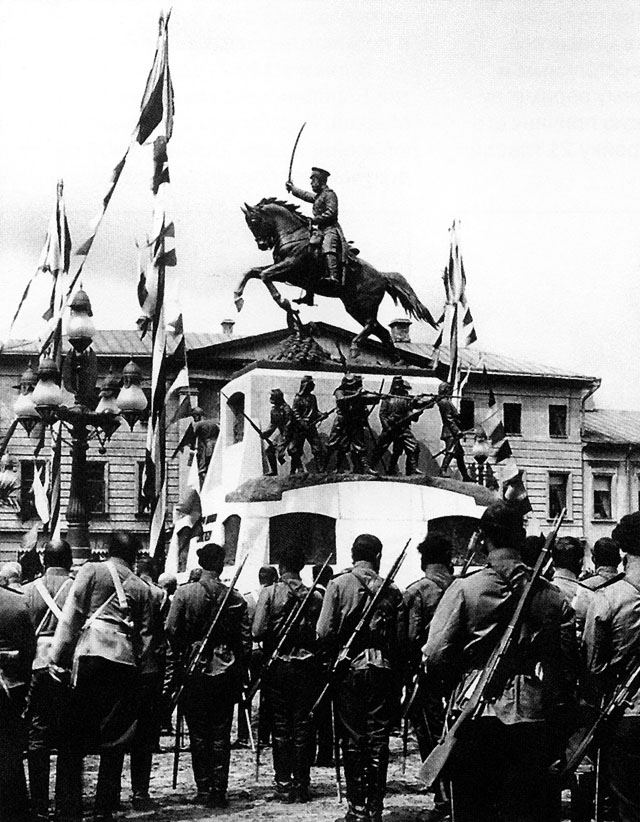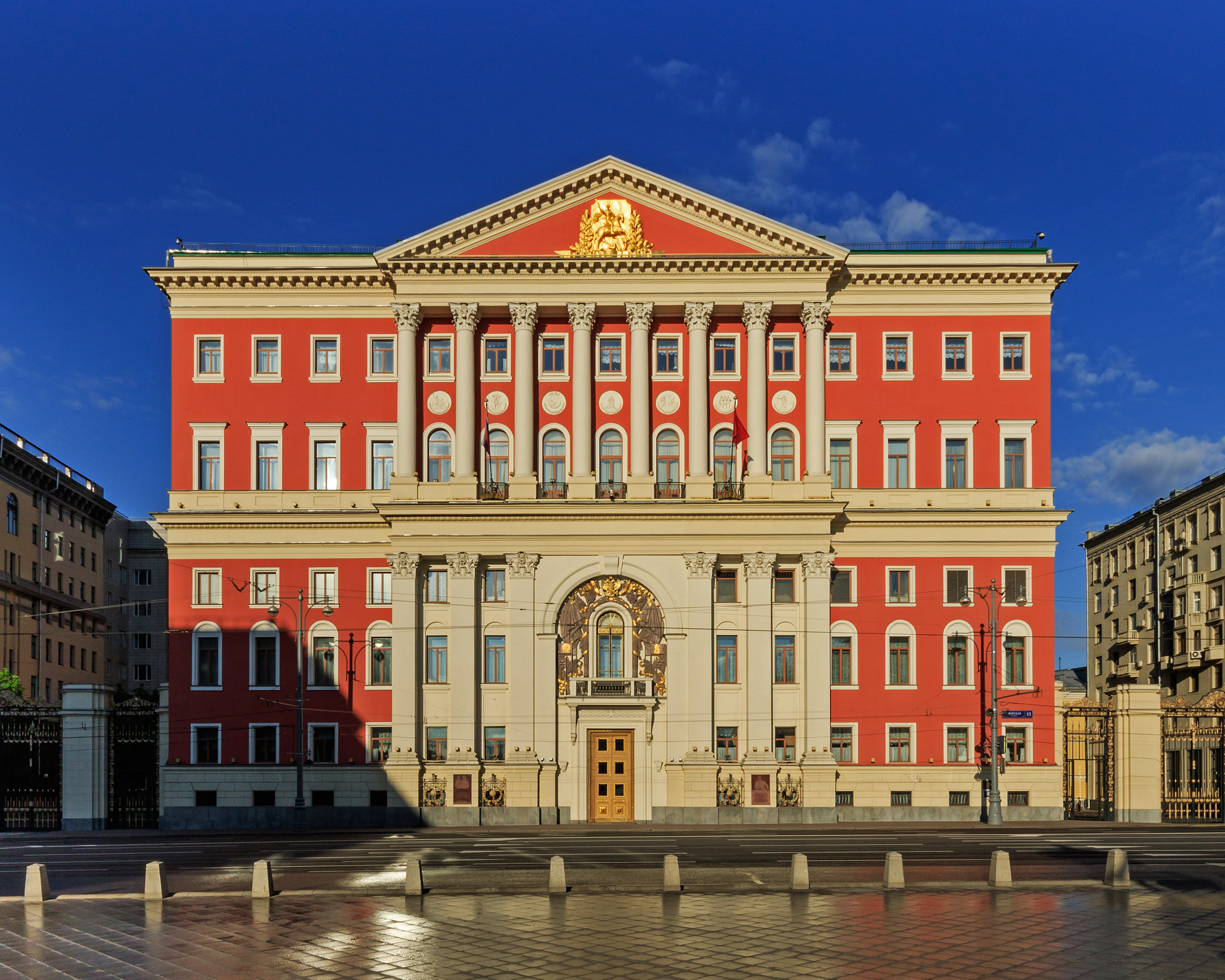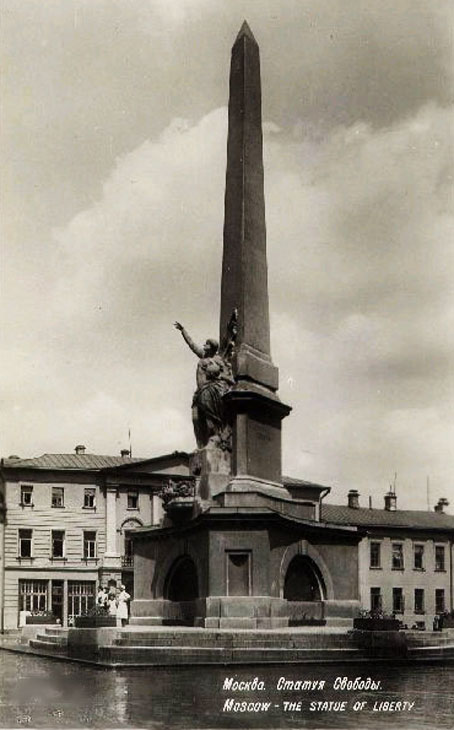|
Statue Of Yuriy Dolgorukiy, Moscow
The Statue of Yuriy Dolgorukiy is an equestrian statue which commemorates the founding of Moscow in 1147 by Yuriy Dolgorukiy (1099 1157). Dolgorukiy was the Grand Prince (''Velikiy Knyaz'') of the Kievan Rus' (Kiev) and a member of the Rurik dynasty. On 6 June 1954, the statue was erected on Soviet Square (now ), located in front of the Mossoviet building (now the building of the Mayor of Moscow). The sculptors were Sergei Mikhailovich Orlov, A. P. Antropov, and Nicholay Lvovich Shtamm. The architectural design was by . The statue replaced the , which had been demolished in 1941. Skobelev statue The original statue erected in 1912 in Tverskaya Square was of General Mikhail Skobelev, a hero of the Russian-Turkish War of 1877. The depicted him mounted on his horse. The monument was known as "The White General". Skobelev wore a white parade tunic and rode a white horse into battle. He was also a member of the Tsar's military force and therefore a "White". Following the Octo ... [...More Info...] [...Related Items...] OR: [Wikipedia] [Google] [Baidu] |
Yuriy Dolgorukiy
Yuri I Vladimirovich ( rus, Юрий Владимирович, Yuriy Vladimirovich), commonly known as Yuri Dolgorukiy or the Long Arm ( rus, Юрий Долгорукий, Yuriy Dolgorukiy, meaning "Far-Reaching", c. 109915 May 1157) was a Rurikid prince. Noted for successfully curbing the privileges of the landowning ''boyar'' class in Rostov-Suzdal and his ambitious building programme, Yuri transformed this principality into the independent power that would evolve into early modern Muscovy. Yuri spent much of his life in internecine strife with the other Rurikid princes for suzerainty over the Kievan Rus, which had been held by his father (Vladimir Monomakh) and his elder brother before him. Although he twice managed to hold Kiev (in September 1149 - April 1151, again in March 1155 - May 1157) and rule as Grand Prince of all Rus', his autocratic rule and perceived foreigner status made him unpopular with the powerful Kievan ''boyars,'' leading to his presumed poisoning and ... [...More Info...] [...Related Items...] OR: [Wikipedia] [Google] [Baidu] |
Russo-Turkish War (1877–78)
The Russo-Turkish wars (or Ottoman–Russian wars) were a series of twelve wars fought between the Russian Empire and the Ottoman Empire between the 16th and 20th centuries. It was one of the longest series of military conflicts in European history. Except for the war of 1710–11 and the Crimean War, which is often treated as a separate event, the conflicts ended disastrously for the Ottoman Empire; conversely, they showcased the ascendancy of Russia as a European power after the modernization efforts of Peter the Great in the early 18th century. History Conflict begins (1568–1739) Before Peter the Great The first Russo-Turkish War (1568–1570) occurred after the conquest of Kazan and Astrakhan by the Russian tsar Ivan the Terrible. The Ottoman sultan Selim II tried to squeeze the Russians out of the lower Volga by sending a military expedition to Astrakhan in 1569. The Turkish expedition ended in disaster for the Ottoman army, which could not take Astrakhan and a ... [...More Info...] [...Related Items...] OR: [Wikipedia] [Google] [Baidu] |
USSR State Prize
The USSR State Prize (russian: links=no, Государственная премия СССР, Gosudarstvennaya premiya SSSR) was the Soviet Union's state honor. It was established on 9 September 1966. After the dissolution of the Soviet Union, the prize was followed up by the State Prize of the Russian Federation. The State Stalin Prize ( Государственная Сталинская премия, ''Gosudarstvennaya Stalinskaya premiya''), usually called the Stalin Prize, existed from 1941 to 1954, although some sources give a termination date of 1952. It essentially played the same role; therefore upon the establishment of the USSR State Prize, the diplomas and badges of the recipients of Stalin Prize were changed to that of USSR State Prize. In 1944 and 1945, the last two years of the Second World War, the award ceremonies for the Stalin Prize were not held. Instead, in 1946 the ceremony was held twice: in January for the works created in 1943–1944 and in June for the ... [...More Info...] [...Related Items...] OR: [Wikipedia] [Google] [Baidu] |
Mikhail Mikhaylovich Gerasimov
Mikhail Mikhaylovich Gerasimov (; 2 September 1907 – 21 July 1970) was a Soviet archaeologist and anthropologist who discovered the Mal'ta–Buret' culture and developed the first technique of forensic sculpture based on findings of anthropology, archaeology, paleontology, and forensic science. He studied the skulls and meticulously reconstructed the faces of more than 200 people, ranging from the earliest excavated homo sapiens and neanderthals, to the Middle Ages' monarchs and dignitaries, including emperor Timur (Tamerlane), Yaroslav the Wise, Ivan the Terrible, and Friedrich Schiller. Early life Gerasimov was born 1907 in St. Petersburg shortly before his doctor father was posted to settlement near Irkutsk. As a child he studied the bones of prehistoric animals that were unearthed during the construction of the area. Gerasimov produced his first reconstructions of prehistoric Neanderthal and Java Man, in 1927 (Gerasimov, p. 5); they are exhibited in th ... [...More Info...] [...Related Items...] OR: [Wikipedia] [Google] [Baidu] |
Joseph Vissarionovich Stalin
Joseph Vissarionovich Stalin (born Ioseb Besarionis dze Jughashvili; – 5 March 1953) was a Georgian revolutionary and Soviet political leader who led the Soviet Union from 1924 until his death in 1953. He held power as General Secretary of the Communist Party of the Soviet Union (1922–1952) and Chairman of the Council of Ministers of the Soviet Union (1941–1953). Initially governing the country as part of a collective leadership, he consolidated power to become a dictator by the 1930s. Ideologically adhering to the Leninist interpretation of Marxism, he formalised these ideas as Marxism–Leninism, while his own policies are called Stalinism. Born to a poor family in Gori in the Russian Empire (now Georgia), Stalin attended the Tbilisi Spiritual Seminary before joining the Marxist Russian Social Democratic Labour Party. He edited the party's newspaper, ''Pravda'', and raised funds for Vladimir Lenin's Bolshevik faction via robberies, kidnappings and protection rac ... [...More Info...] [...Related Items...] OR: [Wikipedia] [Google] [Baidu] |
Tretyakov Gallery
The State Tretyakov Gallery (russian: Государственная Третьяковская Галерея, ''Gosudarstvennaya Tretyâkovskaya Galereya''; abbreviated ГТГ, ''GTG'') is an art gallery in Moscow, Russia, which is considered the foremost depository of Russian fine art in the world. The gallery's history starts in 1856 when the Moscow merchant Pavel Mikhailovich Tretyakov acquired works by Russian artists of his day with the aim of creating a collection, which might later grow into a museum of national art. In 1892, Tretyakov presented his already famous collection of approximately 2,000 works (1,362 paintings, 526 drawings, and 9 sculptures) to the Russian nation. The museum attracted 894,374 (visitors in 2020 (down 68 percent from 2019), due to the COVID-19 pandemic. It was 13th on the list of most-visited art museums in the world in 2020. The façade of the gallery building was designed by the painter Viktor Vasnetsov in a peculiar Russian fairy-tale style. ... [...More Info...] [...Related Items...] OR: [Wikipedia] [Google] [Baidu] |
Nike Of Samothrace
The ''Winged Victory of Samothrace'', or the ''Nike of Samothrace'', is a votive monument originally found on the island of Samothrace, north of the Aegean Sea. It is a masterpiece of Greek sculpture from the Hellenistic era, dating from the beginning of the 2nd century BC. It is composed of a statue representing the goddess Niké (Victory), whose head and arms are missing, and its base in the shape of a ship's bow. The total height of the monument is 5.57 meters including the socle; the statue alone measures 2.75 meters. The sculpture is one of a small number of major Hellenistic statues surviving in the original, rather than Roman copies. ''Winged Victory'' has been exhibited at the Louvre Museum in Paris, at the top of the main staircase, since 1884. Discovery and restorations In the 19th century In 1863, Charles Champoiseau (1830–1909), acting in charge of the Consulate of France in Adrianopolis (now Edirne in Turkey), undertook from March 6 to May 7 the exploration o ... [...More Info...] [...Related Items...] OR: [Wikipedia] [Google] [Baidu] |
МХАТ
The Moscow Art Theatre (or MAT; russian: Московский Художественный академический театр (МХАТ), ''Moskovskiy Hudojestvenny Akademicheskiy Teatr'' (МHАТ)) was a theatre company in Moscow. It was founded in 1898 by the seminal Russian theatre practitioner Konstantin Stanislavski, together with the playwright and director Vladimir Nemirovich-Danchenko. It was conceived as a venue for naturalistic theatre, in contrast to the melodramas that were Russia's dominant form of theatre at the time. The theatre, the first to regularly put on shows implementing Stanislavski's system, proved hugely influential in the acting world and in the development of modern American theatre and drama. It was officially renamed the Gorky Moscow Art Theatre in 1932. In 1987, the theatre split into two troupes, the Chekhov Moscow Art Theatre and the Gorky Moscow Art Theatre. Beginnings At the end of the 19th-century, Stanislavski and Nemirovich-Danchenko b ... [...More Info...] [...Related Items...] OR: [Wikipedia] [Google] [Baidu] |
Konstantin Stanislavski
Konstantin Sergeyevich Stanislavski ( Alekseyev; russian: Константин Сергеевич Станиславский, p=kənstɐnʲˈtʲin sʲɪrˈgʲejɪvʲɪtɕ stənʲɪˈslafskʲɪj; 7 August 1938) was a seminal Russian Soviet Federative Socialist Republic, Soviet Russian theatre practitioner. He was widely recognized as an outstanding character actor and the many List of productions directed by Konstantin Stanislavski, productions that he directed garnered him a reputation as one of the leading theatre directors of his generation. His principal fame and influence, however, rests on Stanislavski's system, his "system" of actor training, preparation, and rehearsal technique. Stanislavski (his stage name) performed and directed as an Amateur theatre, amateur until the age of 33, when he co-founded the world-famous Moscow Art Theatre (MAT) company with Vladimir Nemirovich-Danchenko, following a legendary 18-hour discussion. Its influential tours of Europe (1906) and ... [...More Info...] [...Related Items...] OR: [Wikipedia] [Google] [Baidu] |
Nikolay Andreyev
Nikolay Andreyevich Andreyev (russian: Николай Андреевич Андреев; – 24 December 1932) was a Russian sculptor, graphic artist and stage designer. As a young man Andreyev studied with Sergey Volnukhin and in 1902 became associated with the Peredvizhniki group of realists. Andreyev's brother V.A. Andreyev was also a sculptor. A native of Moscow, Andreyev was the designer of two Moscow statues known for their removal. One is the seated bronze figure of Gogol, with bronze friezes of Gogol's greatest characters surrounding the base, finished in 1909 and placed on Gogol Boulevard. Criticized for its impressionistic style and dark mood, said to be hated by Stalin himself, it was moved in 1952 amid controversy, and replaced with a straightforward Soviet-style representation of Gogol by sculptor Nikolai Tomsky. Similarly Andreyev's figure of "Freedom" (loosely, the "Statue of Liberty") was erected with a 26-meter obelisk in Tverskaya Street in 1919, to commemo ... [...More Info...] [...Related Items...] OR: [Wikipedia] [Google] [Baidu] |
Mossovet
The Mossoviet (Russian: Моссовет), an abbreviation of Moscow Soviet, (Московский Совет) was established following the February Revolution . Initially it was a parallel, shadow city administration of Moscow, Russia run by left-wing parties. Following the October Revolution it became the city administration of Moscow throughout the Soviet period (1918–1991). Initial period The first meeting of the Moscow Soviet of Workers’ Deputies occurred on 1 March, 1917. The meeting was initially attended by 52 delegates from various factories, cooperative societies and trade unions. However when the meeting was reconvened in the evening after a short adjournment, the meeting had swollen to over six hundred delegates. An executive committee of 44 members was created under the leadership of Lev Khinchuk a member of the Menshevik faction of the Russian Social Democratic Labour Party. After the Bolshevik seizure of power Between 1918 and 1941, these two administrations ... [...More Info...] [...Related Items...] OR: [Wikipedia] [Google] [Baidu] |
Monumental Propaganda
Lenin's Plan of "Monumental Propaganda" – is a strategy proposed by Vladimir Lenin of employing visual monumental art (revolutionary slogans and monumental sculpture) as an important means for propagating revolutionary and communist ideas. "The plan" had the significance of creating a large demand for monumental sculpture on a state level, and thus it stands at the origins of the Soviet school of sculpture. The "plan" consisted of two main projects: (1) – decorating buildings and other surfaces "traditionally used for banners and posters" with revolutionary slogans and memorial relief plaques; (2) – vast erection of "temporary, plaster-cast" monuments in honor of great revolutionary leaders. Plan Realization of the plan was initiated with a decree issued by Sovnarkom (the Council of People's Commissars) "On Republic's monuments" (sanctioned 12 April 1918), which ordained removal of monuments "erected in honor of tzars and their servants" and the development of projects for ... [...More Info...] [...Related Items...] OR: [Wikipedia] [Google] [Baidu] |










